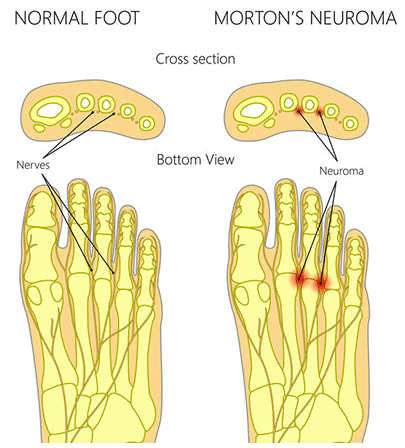What is Morton’s Neuroma?
If you have been experiencing pain in the ball of the foot, it could be Morton’s Neuroma- one of the most common forefoot disorders.
When there is excessive compression in-between the metatarsals (the long bones of the foot) due to abnormal mechanics of the foot and ankle and/or tight-fitting shoes, the nerve fibers that run between the metatarsals are put under mechanical stress.
As a result, the “insulation” around the nerves thickens due to the build-up of scarred or fibrotic tissues forming a lump that causes burning or sharp pain in the ball of the foot.
Pinched nerve symptoms such as pins and needles, tingling and numbness are common and may radiate to the toes. Without appropriate treatment, more scar tissues may develop and the affected nerves would continue to enlarge, causing intense symptoms that limit your footwear option and additional time and cost for treatment.
How do I tell if I have a neuroma? Do I need x-ray, ultrasound or MRI?
One of the challenges when it comes to diagnosing neuroma is that there are many other differential diagnoses that share the similar symptoms as a neuroma, such as bursitis, synovitis, stress fracture, plantar plate ligament tear, or even a painful corn! Identifying the exact tissue under stress is important to ensure proper treatment.
A validated study (Pastides et al., 2012) comparing hands-on clinical assessment with MRI and ultrasound diagnostic imaging concluded that hands-on assessments are more sensitive and accurate in diagnosing a neuroma compared to both MRI and ultrasound. Yes, that’s right! your clinician’s hands are better than imaging methods at detecting a neuroma. However, an ultrasound or MRI may still be indicated to measure the size or make-up of the neuroma
The Podiatrists at the MyFeet Clinics have been trained to identify or rule out the condition without the hassle or expense of diagnostic imaging.
Before requesting for diagnostic imaging, or if you already had an ultrasound or MRI done but nothing was detected, come in and see us. We will be able to provide an accurate diagnosis and detect the underlying cause of it so that we can come up with an effective treatment plan to get you walking pain-free again!
Our Treatment Approach
Since irritation to the forefoot nerves is usually the main developing cause of Morton’s neuroma, our treatment focus on eliminating the mechanical stress on the forefoot, or else symptoms will likely arise in other areas of the foot even after a surgical neuroma excision. We have had great success resolving neuroma symptoms by using a combination of advanced treatment methods to release surrounding soft tissues that irritate the neuroma and restore the foot function.
Foot Orthoses can also be helpful in redistributing abnormal force on the foot to offload the forefoot stress.
At the MyFeet Clinics, we accurately assess, diagnose and employ a corrective treatment approach to improve symptoms and address the underlying cause for Morton’s Neuroma, by using a combination of specialized treatment techniques that we have mastered, which may include:
- Foot Mobilisation Techniques
- Custom Foot Orthoses
- Corrective / Rehabilitation Exercise
We will customise a treatment plan suitable to meet your health or training goals!
Call us today to book a time or discuss your pain and concerns with us!



